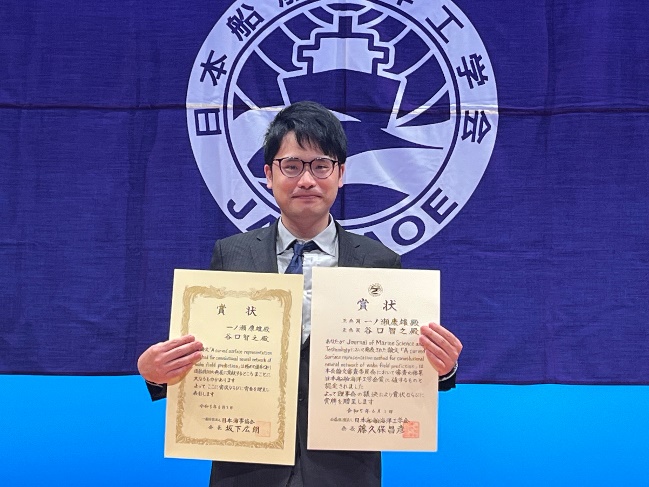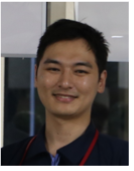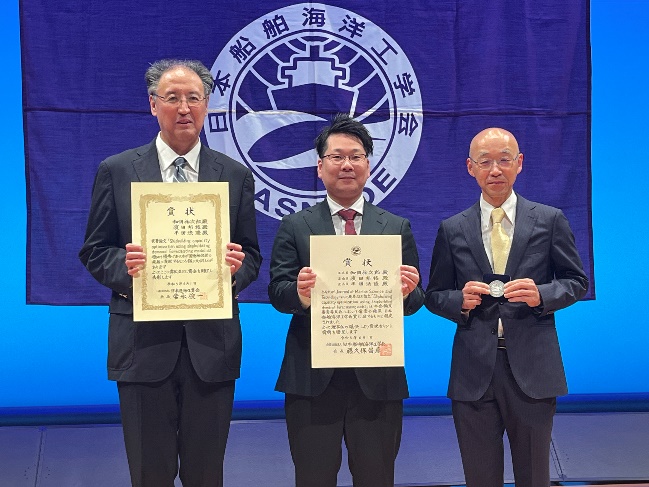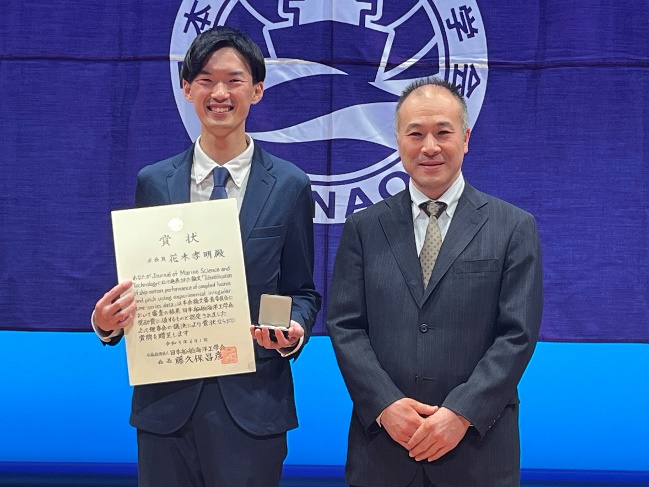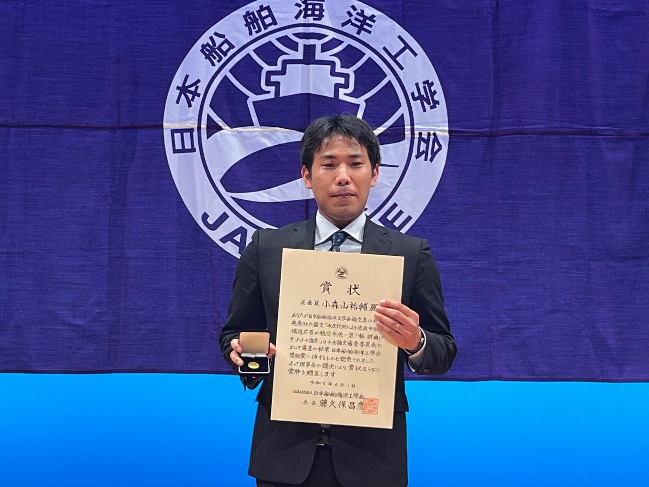News
NEWS
National Institute of Maritime, Port and Aviation Technology
Dr. Ichinose, Chief Researcher, Dr. Taniguchi, Chief Researcher and Dr. Wada, Chief Researcher received the Best Paper Award, and Dr. Hanaki and Mr. Komoriyama, Researcher received the Best Paper Award for the Youth (“Inui Award”) from the Japan Society of Naval Architects and Ocean Engineers.
On June 1, 2023, the awards ceremony of the Japan Society of Naval Architects and Ocean Engineers (JASNAOE) was held at Kesennuma Central City Hall and online. This institute received a total of four awards, the Best Paper Award and the Best Paper Award for the Youth (“Inui Award”).
Dr. Ichinose Yasuo; Chief Researcher of the Fluids Engineering & Hull Design Department, Dr. Taniguchi Tomoyuki; Chief Researcher of the Structural & Industrial System Engineering Department and Dr. Wada Yujiro; Chief Researcher of the Knowledge & Data System Department received the Best Paper Award1. Dr. Hanaki Takaaki; Researcher of the Fluids Engineering & Hull Design Department and Mr. Komoriyama Yusuke; Researcher of the Structural & Industrial System Engineering Department received the Best Paper Award for the Youth (“Inui Award”)2.
1 Best Paper Award: This award is given to outstanding papers on shipbuilding, machine building, ocean engineering and other maritime fields that have been published.
2 Best Paper Award for the Youth (“Inui Award”): This award is given to young researchers who have published original and outstanding papers to encourage creative research in the fields of naval architecture and ocean engineering and to promote the development of the technology widely.
1.Best Paper Award and ClassNK Award
Paper title:A curved surface representation method for convolutional neural network of wake field prediction, Journal of Marine Science and Technology, Vol. 27, issue 1, March 2022.(About the research)
Machine learning (ML) applications for ship design have been developing since the 1990s. However, due to the limited input parameters of neural networks in early research, it was necessary to represent the complex three-dimensional shape of the hull using fewer than 20 parameters of its shape, which hinders the widespread use of ML in ship design practice.
This paper proposes a method for representing the three-dimensional surfaces of ships, aircrafts and the other objects by the convolutional neural networks developed for the image analysis. The method can express surface shapes with more than 20,000 data points for input into the ML models. Moreover the proposed ML model can treat vector values such as the flow field on the propeller plane and the pressure distribution on the hull surface, whereas the previous ML models for ship design were limited to predicting only scalar values such as wave-making resistance. The method enables reducing the computation time in the fluid analysis to 100,000 times faster. Hence, the method can contribute to the future breakthrough of the advanced integrated ship design, in which the computational time for the fluid analysis is a bottleneck in the multi-objective optimization such as combination with the arrangement, the stability and the structure.
(The recipients of the award)
Ichinose Yasuo; Fluids Engineering & Hull Design Department, National Maritime Research Institute, MPAT
Taniguchi Tomoyuki; Structural & Industrial System Engineering Department, National Maritime Research Institute, MPAT
2. Best Paper Award and Shipbuilders’ Association of Japan Award
Paper title:Shipbuilding capacity optimization using shipbuilding demand forecasting model, Journal of Marine Science and Technology, Vol. 27, issue 1, March 2022.(About the research)
The shipbuilding market is susceptible to prolonged imbalances in supply and demand, and the current excess of the shipbuilding capacity continues to affect the industry. The Shipbuilding Committee of the Organization for Economic Cooperation and Development (OECD) is discussing ways to resolve this issue. However, there has been no quantitative analysis of the impact of the shipbuilding capacity on the shipbuilding market nor appropriate adjustment scenarios have been presented. This study aims to clarify the appropriate adjustment scenarios for the shipbuilding capacity and their effects to ensure the sustainable development of the shipbuilding industry.
In this paper, we have developed a model and a system to evaluate the impact of scenarios involving expansion or reduction of the shipbuilding capacity on the shipbuilding market and to explore the optimal scenarios. Using the developed model and the system, we conducted various simulations and comprehensively analyzed the overall impact of the shipbuilding capacity on the market. Simultaneously, we have also provided discussions regarding the appropriate adjustment scenarios.
(The recipients of the award)
Wada Yujiro; Knowledge & Data System Department, National Maritime Research Institute, MPAT
Hamada Kunihiro; Graduate School of Advanced Science and Engineering, Hiroshima University
Hirata Noritaka; Graduate School of Advanced Science and Engineering, Hiroshima University
3. Best Paper Award for the Youth (“Inui Award”)
Paper title:Identification of ship motion performance of coupled heave and pitch using experimental irregular time-series data, Journal of Marine Science and Technology, Vol. 27, issue 2, June 2022.(About the research)
In the performance evaluation of ship motion in actual seas, both the theoretical approach and the measured data analysis are important. However, the conventional spectral analysis method using the measured data identifies only a response system of waves and the ship motion that are measured as one of the physical quantities. The method cannot evaluate the physical phenomena inside the system as the frequency response.
In this paper, we realized a self-organizing state-space model based on the equation of motion considering the memory effect and developed a method to identify the model parameters using the time-series data of irregular waves and the ship motion. The proposed method is validated by comparing the parameters of the motion-free test of a ship model in irregular waves with the conventional ones. This study clarifies the characteristics of hydrodynamic forces acting on a ship hull and identifies a response system of waves and the ship motion. The results of the research will lead to highly reliable performance evaluation in actual seas.
(The recipients of the award)
Hanaki Takaaki; Fluids Engineering & Hull Design Department, National Maritime Research Institute, MPAT (Graduate School of Engineering, Osaka University; at the time of research)
Co-author: Minoura Munehiko; Graduate School of Engineering, Osaka University
4. Best Paper Award for the Youth (“Inui Award”)
Paper title: A Novel Technique to Estimate Hull Structural Response in Waves by means of Hydrodynamic Pressure Measurement -1st report: Estimation for vertical bending moment-, Journal of the Japan Society of Naval Architects and Ocean Engineers, Vol. 35, June 2022.(About the research)
Understanding the hull structural response in waves is important for the safe hull design. In recent years, improvements in computer performance have made it possible to determine the structural response in waves using the direct load and structure analysis that combines the load analysis (Strip method, Panel method, etc.) and the finite element analysis (FEA). With the development of such numerical analysis techniques, experiments for validation of accuracy become more important. Therefore, as a novel validation technique, a method to estimate the hull structural response in waves from the water pressure on the surface of a ship model measured in tank tests is proposed and validated.
The proposed method has following features; (1) water pressure on the surface of a ship model is measured at many points in tank tests using Fiber Bragg Gratings (FBG) pressure sensors, (2) the water pressure distribution on the surface is obtained by interpolating the measured water pressure considering the free surface position and (3) estimation of the hull structure response in waves including the local response by performing FEA with the obtained water pressure distribution as the load. As the validation for the proposed method, tank tests were conducted using an acrylic flexible ship model whose hull strain can be measured. Comparison between the vertical bending moment obtained by the proposed method and that obtained by the conventional method based on measured strain shows good agreement and indicats the validity of this method.
(The recipients of the award)
Komoriyama Yusuke; Structural & Industrial System Engineering Department, National Maritime Research Institute, MPAT

